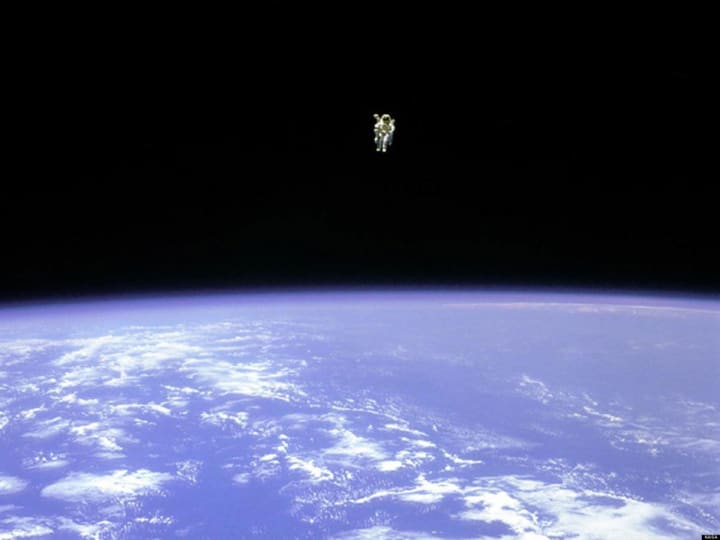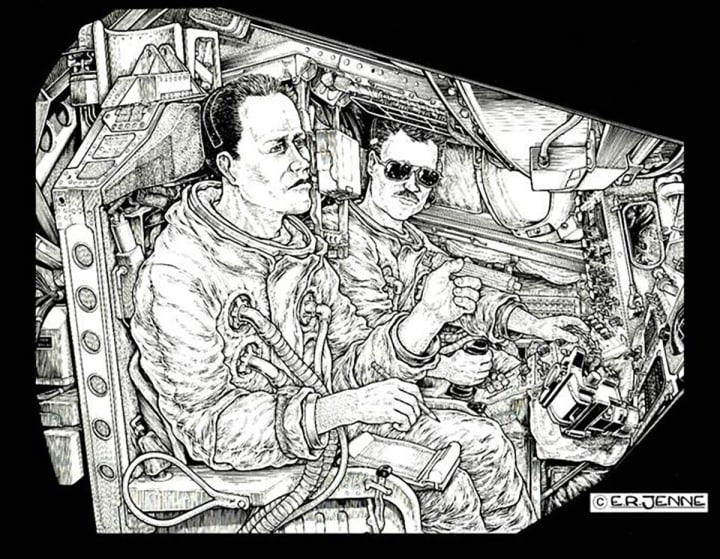Q&A with 'Blue Gemini's' Mike Jenne
Mike Jenne's thriller 'Blue Gemini' is a must read for all sci-fi and history fans alike.

The year is 1968: The Cold War is far from over, nuclear annihilation is always only a heartbeat away. America is racing the Soviet Union to land men on the Moon, a war is raging, and a pivotal presidential election looms on the horizon. A child of the early space age, Lieutenant Scott Ourecky joined the Air Force with aspirations of going to flight school. A brilliant engineer, he repeatedly fails the aptitude test to become a pilot but is selected to work on a highly classified military space program—the innocuously named Aerospace Support Project—in which Air Force astronauts are slated to fly missions to intercept and destroy suspect Soviet satellites. When one of the astronauts in training abruptly falls out of the project, Ourecky is asked to fill in for the two-man simulated missions and survival training. Although Ourecky was only a temporary “place holder,” not destined to fly in space, he soon finds himself much more involved than he ever anticipated—and in deepest peril.
OMNI had the opportunity to sit down with author Mike Jenne about his new thriller, Blue Gemini. Jenne is a licensed pilot, life-long aerospace aficionado, and amateur space historian. His first novel, Blue Gemini, is the first installment of a series; with Blue Darker Than Black and Pale Bluereleased in the first and second halves of 2016. As a child, he felt the ground shudder often––as the Saturn V moon rockets were tested at nearby Marshall Space Flight Center. Trained as an Army Ranger and Military Freefall (“HALO”) Parachutist, he is a former Special Forces officer who has served across the globe. Mike and his wife, Adele, make their home in Alabama.
The hero of Blue Gemini, Scott Ourecky, is an intricate and composed character. His life is a product of childhood wonderment mixed with the complexities and responsibilities all mankind must face. Ourecky’s early infatuation with space is a sensation that we all have encountered in life; what secrets lie within the sky, and how can we reach them? Readers will find an easy relatability to Ourecky’s story, passion, and aspirations. He is a constant reminder that any journey, no matter how long, is worth pursuing. Mike Jenne’s first novel beautifully portrays man’s interest in greatness of all forms; through life, space, and love. We follow in wonderment as man faces adversity to achieve his ambitions, reminding us all of our basic, human core. Take a look at Mike Jenne’s interview with OMNI, and see if the stars will beckon you too...

Image via NASA
OMNI: What inspired you to write your first novel, Blue Gemini?
Mike Jenne: I’ve always enjoyed writing, and was always captivated by the space program. I’m also a student of history, and am particularly fascinated with the Cold War era. The Cold War period was an amazing time, and there was plenty of stuff that went on behind the scenes that we may never know about. Nowadays, few people are aware that both the US and Soviet military had developed plans to fly military astronauts into space, at the same time the civilian Space Race was ongoing, so that was a natural starting point for Blue Gemini. The series follows characters who are involved in a secret Air Force manned space program which uses a modified version of the Gemini spacecraft to conduct surreptitious IIK (Intercept – Inspect – Kill) missions against Soviet satellites suspected of carrying nuclear weapons. The Gemini was an extremely capable and versatile spacecraft, but NASA all but discarded it as they rushed to land men on the Moon. The Air Force originally intended to continue flying Gemini, in various roles, but these programs eventually went by the wayside; the Blue Gemini series implies that they weren’t cancelled, but flown in secret.
How much of Lieutenant Scott Ourecky's life parallels your own?
Not nearly as much as you might suspect. Of course, both of us were fortunate enough to have grown up in this remarkable era, although Ourecky would have been a few years older than me. But other than an interest in space flight, I have very little in common with Ourecky. As the story describes him, he’s a gifted genius in math and engineering, while I consider myself fortunate if I can keep my checkbook balanced and change the oil in my car. We both dreamed of becoming astronauts and built spacecraft mock-ups as children, but I think that was a common experience for kids who grew up in that age. Of course, Ourecky diligently continued along his path to becoming an astronaut, joining the Air Force with the goal of becoming a pilot, but my astronaut dreams were dashed in my adolescence, as I realized my eyes were too bad to pursue military flying, and I was also not very strong in math and science. Likewise, I didn’t pursue a career in professional sports, since I was too small, too slow, and lacked good hand-eye coordination. But if there is a significant similarity between Ourecky and myself, I think that as a result of our unusual military careers, we both have plenty that we can never share with our friends and family. Oh, and there is one other thing: Ourecky and I both married very pretty ladies who are also exceptionally smart and self-sufficient. Adele is definitely the math whiz in our family.
Can you describe your writing process?
It might seem sort of odd, but I’ve adapted a lot of my writing process, at least the organization aspects, from my military special operations background. The military teaches something called the “backwards planning process.” In backwards planning, you first define the objective of the mission, and then you effectively work backwards to construct a plan, identify the resources necessary to execute that plan, and shape your schedule to transition from your current situation to the successful outcome of the mission. Surprisingly, it works just as well for writing a techno-thriller as it did when I was a scrawny nineteen-year-old Ranger School student, hungry and half-asleep, huddled under a poncho on a dark and rainy night, fighting exhaustion as I scribbled out my scheme to raid a mock-up Soviet radar site at dawn. Anyway, once I’ve developed the overarching and supporting themes for a book, I draft a rough outline (working from start to finish) of how I envision the overall progress of the story. Then I use an Excel spreadsheet, working backwards (mostly) to build scenes and chapters.
I have a specific objective for each scene, which might be to introduce a new character or plot detail, or to set the stage for something that will occur later in the story. Using these sort of tools helps me to maintain accountability, particularly for a complex series like Blue Gemini, where there are a lot of moving pieces. As an example, in order for Z to happen, then Y must happen at least a few weeks earlier, and X must precede that, and so on. The Excel spreadsheet is also especially helpful for tracking the supporting details within the plot. The story precedes chronologically, so my spreadsheet is laid out on a corresponding day-to-day basis, so I know where different characters are on any given day, and what events (fictional and historical) are occurring around them. As an example, there’s a passage in the second book where General Mark Tew lands at Johnston Island (a remote island in the Pacific) aboard Air Force One. Air Force One did in fact land there that day, as described in the book, carrying President Nixon on his way to the USS Hornet to witness the return of Apollo 11.
How much research was involved in the writing of Blue Gemini?
It may sound a little far-fetched, but I would estimate that I dedicated at least half a day for every page in the finished product. And the research wasn’t just about spacecraft and spaceflight, but spanned a fairly vast range of topics including historical events, geography, military history, the Soviet Union, cultural events, popular music, television shows, etc..
In the course of my research, I learned a lot about this era. Just for fun, I’ve buried a lot of itty-bitty trivia nuggets throughout the books, but I doubt that there will be many readers who glean them all. As a case in point, in the first book, when Mark Tew wakes up in the middle of the night and looks at his watch, there’s something very significant about the time. In the second book, when Air Force “PJ” Steve Baker touches the heatshield of the Gemini-I when he’s talking about leprosy, I’m paying homage to someone (actually, a man and his son) but I suspect there are only a handful of people who can make the connection without resorting to Google. Also, if someone goes to the trouble of plotting the military grid coordinates from Matt Henson’s search training in the first book they’ll quickly find out that they won’t show up on modern maps of Eglin Air Force Base. Why is that? And where did Virgil and Bea get their names? Speaking of Bea, why does she look like Barbara Eden? Here’s a clue: Your first answer is wrong.

'Blue Gemini' illustration, via Ed Jenne Illustration
Do you have any tips for aspiring writers interested in the space and astronaut genre?
You’ll be writing for an extraordinarily tough and demanding audience, so you had better do your homework. I think that setting a story in the present day or even the future lends a writer a considerable amount of wiggle room, but don’t expect much if you’re superimposing a story on top of past events. The Blue Gemini series takes place during an extremely well documented time in history; consequently, I might be able to ask my readers to suspend some disbelief, but not very much. In order to remain true to the story, I was compelled to stick closely with the technological constraints of the era; I didn’t have the luxury of “inventing” any special widgets to solve problems within the story. With that said, I suspect that many readers will have a difficult time comprehending a world where cell phones aren’t available to allow instantaneous communications, or where there’s not a computer on every desk, and where immensely complicated machines---Saturn V moon rockets, SR-71 Blackbirds, nuclear weapons, and the like---are designed by very smart people employing scarcely more than slide rules, pencils and paper blueprints to bring their ideas to life.
So, prospective aerospace fiction writers, just how demanding can your readers be? Here’s an example, albeit somewhat long-winded. In order to effectively convey what it would be like to be in that Gemini-I cockpit, I embedded a lot of technical chatter in the dialogue between Carson and Ourecky. That’s not unlike a normal interaction in any cockpit; it’s a busy place, especially at critical intervals, so any personal conversation typically takes place in the narrow seams between communicating about the pressing matters at hand. Anyway, when I wrote that dialogue, I tailored the exchanges to address three levels of readers. The first level are those folks who will accept the dialogue as appropriate background noise for the passage; they might not have a clue what the guys are talking about, but it sounds right for the circumstances, so they sort of glide through those portions and accept them as plausible. The second level readers are those people who understand the technical aspects of the dialogue, if only at a surface level that takes in the terminology and fundamental concepts.
The third level reader is someone who not only comprehends the dialogue, but also the minute nuances and numbers behind the exchange. Many of these folks are literally rocket scientists, and if you can convince them of a scene’s veracity, then you’ve accomplished something truly significant. One of the first Blue Gemini readers I heard from was a manager at NASA’s Johnson Space Center at Houston. He was quick to tell me that he enjoyed the story (especially since the geeky smart guy gets the girl and also saves the day) and that he found no technical errors in the book. He did have one minor “quibble,” though, which concerned a Gemini-I cockpit exchange which described Delta-V settings for reentry. He didn’t say that my numbers were wrong, but that they were correct, and wanted to know how I could have possibly known this, because my stated “up” vector component was counter-intuitive even to experienced engineers whose bread and butter was orbital mechanics. Sufficed it is to say, I explained how I came up with those numbers, and he was happy with the explanation. So, as you summon up the courage to write for this audience, don’t just expect that your works will be nitpicked, but be ready for the nits of those nits to be picked as well.
What is your favorite quote from Blue Gemini?
My favorite sentence is the last sentence in the book: “Only minutes later, they were both sound asleep, and for the first time in weeks, he didn’t dream of flight, but only of her.” Why? While there’s a lot of science and technology in Blue Gemini, at its core, it’s very much a human story that concerns the challenges faced by ordinary people when they are called upon to do extraordinary things. In this scene, Scott Ourecky and his wife---Bea---have both endured a very stressful week at their respective jobs; exhausted, they fall asleep on the couch, in each others’ arms. Throughout the series, Ourecky struggles to maintain his marriage as Bea strongly suspects that he isn’t telling her the whole truth when he constantly claims that he’s just a simple engineer in the Air Force. At the same time, he is saddled with a high stakes job that is all-consuming, that not only occupies almost every waking moment, but dominates his dreams as well. So, in this intimate---and unconscious---moment with Bea, he’s offered a brief respite from those pressures.
Blue Gemini incorporates aspects from both historical fiction and science fiction. How do you think this separates the book from others like it?
Actually, I have a hard time defining a genre for Blue Gemini. There’s certainly a lot of science heaped in with a lot of fiction, but it’s certainly not your typical science fiction book. I definitely think that it’s closer to historical fiction, because so much of the story is drawn from actual historical events.
Several folks have tried to pigeonhole the series into the alternative history genre, but while that’s a close call, I don’t think it’s an accurate description. In Blue Gemini, I contend that I’ve created such a parallel history so plausible that I would challenge anyone to prove that could not have happened, or---perhaps even more relevant---that it did not happen. And if there’s a difference between my books and similar works, that’s the critical distinction.
To achieve this degree of plausibility, I had to create aspects of the program from the ground up, which was sometimes very challenging. The tenets of orbital mechanics decree that you can’t launch spacecraft from the usual sites---Cape Canaveral and Vandenberg Air Force base---to chase Soviet satellites in high inclination orbits, so I had to identify a plausible launch site for the Gemini-I missions. And you shouldn’t surreptitiously insert a manned spacecraft into orbit without devising an effective mechanism to rescue the crews if they come down in the wrong place, so I was compelled to formulate a worldwide network of clandestine recovery sites and the forces to man them. And once you intercept a suspect satellite and decide that it’s hostile, how do you knock it out of the sky? Furthermore, how do you accomplish this if you’re limited to some sort of device that can be readily carried to orbit aboard a Gemini spacecraft? Answer: The “Multi-Function Disruptor.” I can’t take full credit for that solution, though; my brother Ed came up with the lion’s share of the Disruptor design, and his contributions are both simple and elegant.
What would you like your readers to take away from this new series?
Besides taking readers on a journey into an era and terrain that might not be familiar to them, I also wanted to convey some insights into the nature of duty and commitment, particularly for those readers who don’t have the benefit of a military background. I think that many readers will be very surprised where this series goes in the third book, so I believe it’s important to remind people that this is a story of the Cold War, and that conflict was fought on many fronts, with some battlefields much more kinetic than others.
What can the reader expect from the upcoming sequel, Blue Darker Than Black?
Readers should expect a very fast and very wild ride that will take them to some places that they probably wouldn’t expect to go. At least one of these detours is intended as a clear reminder that it’s possible to be very close to home but yet still be in grave danger. Beyond that, a considerable amount of Blue Gemini is dedicated to explaining the concepts and technology of the program; when the reader transitions to “Blue Darker Than Black,” the training wheels come off. If you read Blue Gemini, you already know your way around the Gemini-I cockpit and you know the mechanics of killing Soviet satellites. So clear your thoughts, stow your tray table, put your seat in the upright position, take a deep breath, and hold on tight.
Based on a real secret space program, Blue Gemini combines high-altitude action with edge-of-your-seat storytelling to create a modern Cold War thriller. When one of the astronauts in training abruptly falls out of the project, Scott Ourecky is asked to fill in for the two-man simulated missions and survival training only, serving with a headstrong and abrasive test pilot, Major Drew Carson, until another astronaut can be assigned. By far the most proficient pilot assigned to the project, Carson has a dangerous propensity to engage in “pick-up” dog fighting sessions while on cross-country training flights. And although Ourecky was only a temporary “place holder,” not destined to fly in space, he soon finds himself much more involved than he ever anticipated—and in deepest peril.
About the Creator
Natasha Sydor
brand strategy @ prime video






Comments
There are no comments for this story
Be the first to respond and start the conversation.